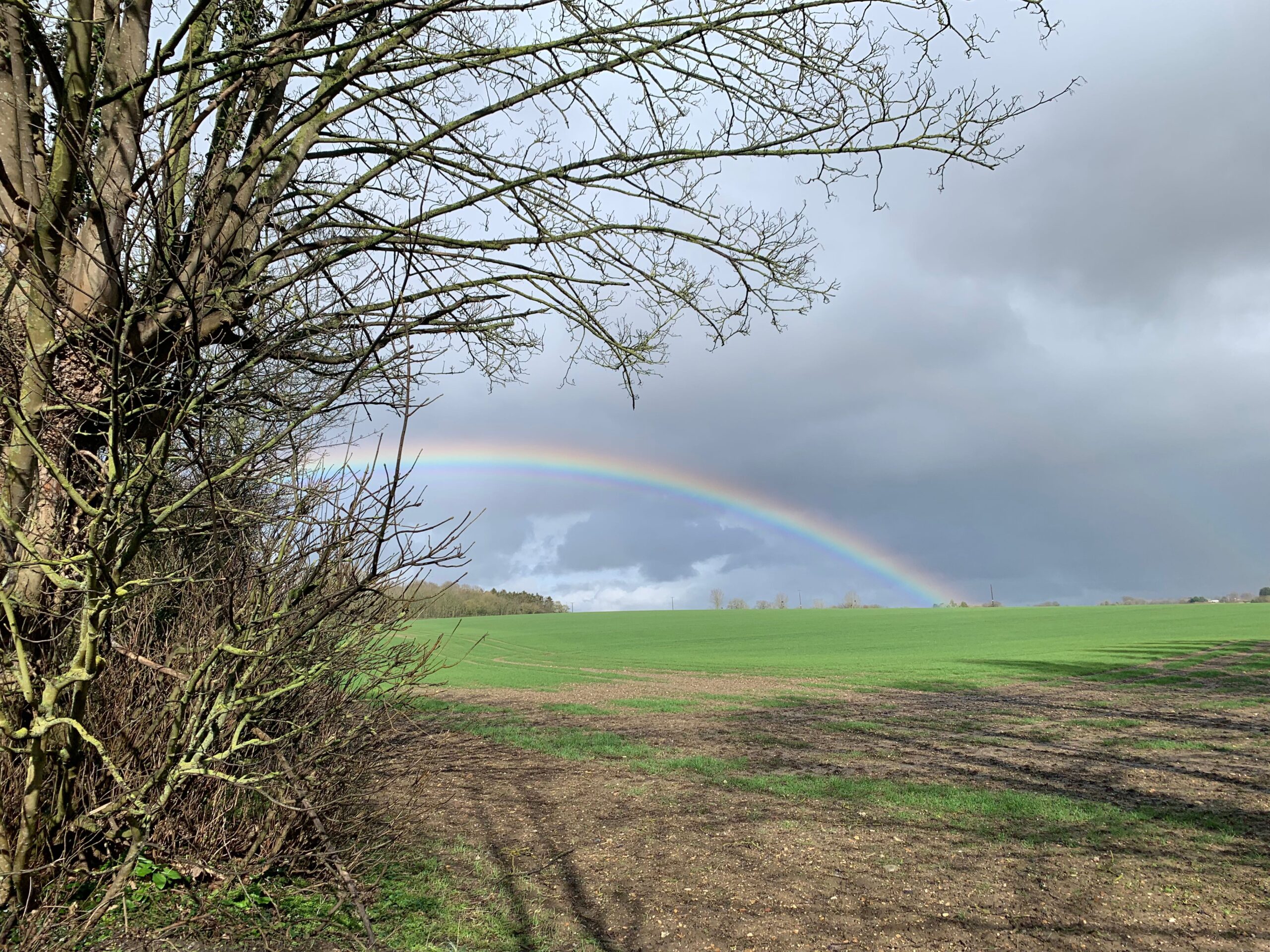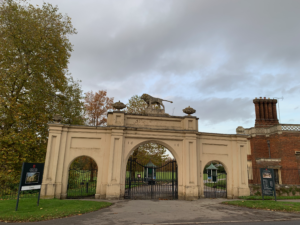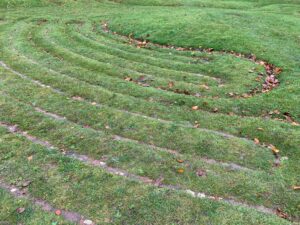Saturday 2nd March 2024
Guidebook: 12.2 miles
My Garmin: 14.3 miles
Breakfast is delicious at the Chantry Hotel: fresh fruit with yoghurt and granola, followed by a full English, all washed down with excellent coffee. When I tell the kind lady who serves me that I’m on a walking pilgrimage to Walsingham, a guest at the next table tells me she loves Walsingham too. When her children were young, she says, she used to take them to Holkham beach for the day, stopping on the way at Walsingham to say a prayer to Our Lady.
I tell her about Andy Bull’s guidebook, but she says she is too old now, and her husband too unwell, for her to be able to walk so far. She wishes me blessings on my pilgrimage, and I leave the dining room feeling encouraged for the day ahead.
A friendly taxi driver, and a sunny churchyard

My taxi arrives on time to take me to Stansfield where I ended my walk in November. The driver is very friendly, and I learn that he comes from Romania, and that his wife is a nurse from Cebu in the Philippines. I once visited Cebu myself, back in 2016, on a midwifery elective. It’s a teeming, tropical city, very different from green and sedate Suffolk. I wonder how it must feel to leave home and family behind and come here to work in the NHS.
Last time I was in Stansfield, the church was a dark shape in the gloom. This morning it appears as an attractive flint-faced building with a square tower. The sun is shining (though rain is forecast), and there are primroses blooming in the churchyard. The church is locked, so I sit down in the porch to unfurl my hiking poles, admiring a pretty display of grape hyacinths on a window ledge. Then it’s time to set out across the road and along a footpath.
Soggy mud
The ground is slippery with soggy mud. It’s been one of the wettest springs on record, and, true to form, the rain soon begins. It’s cold too. I use the hiking poles to help me negotiate the sodden ground, but my exposed hands are quickly freezing. I wish I’d brought gloves. I haven’t walked a mile yet, and it’s already hard going.
Vanished saints and lost children
Fortunately it’s not far to the next village of Hawkedon. Here a church sits surrounded by a wide villlage green, and I hurry towards it, hoping for shelter from the driving rain. There are empty niches in the porch where saints’ statues would once have stood before the Reformation. Inside, on the carved rood screen, you can still see the outlines of painted saints, scratched away, and remaining in traces, like ghosts. There are carved pew ends too, but many have been defaced. I’m grateful to find the church open, and happy to discover a pilgrimage stamp, but the hints of a lost past tinge my mood with sadness.
The church is dedicated to Saint Mary, and the present building dates from the fourteenth and fifteenth centuries, although there was a church building here in Norman times. Fragments of medieval stained glass are incorporated into the more modern windows, including a wolf – maybe associated with Saint Edmund – and a scallop shell for pilgrims and Saint James. Pilgrims on their way to Bury St Edmunds and Walsingham have been visiting this little church for centuries.
I notice a memorial on the wall to a child, Philip Hammond, who died on Sunday the 10th of September 1775, ‘aged five months and ten days.’ There is a world of poignancy in those ‘ten days’. I imagine the heartbroken parents, recalling through tears every precious day of their baby’s too-short life.
On the opposite wall is another memorial, to an eighteen year old girl who died in 1826. In the visitors’ book, someone left a note only yesterday asking for prayers for a couple whose have lost a child. Through all the centuries, mothers and fathers grieve for their children. I recall the painting in the cathedral of Mary meeting Jesus on the way to the cross. Some things never change

The highest point in Suffolk
Feeling pensive, I leave the church and turn uphill. There are plenty of daffodils scattering the village green with cheerful yellow, and my mood lifts as the weather starts to clear. A footpath takes me across fields, skirting the rather grand Hawkedon House, before I join a quiet lane to walk to the next village of Rede, now bathed in spring sunshine.
Rede apparently stands at the highest point in Suffolk, at a not-so-towering 380 feet above sea level. I did admittedly walk up a small hill to get here, but can only conclude that Suffolk must be a remarkably flat county!
A blessing written in code
The village is charming. I spot the church tower and make for it, but then it disappears behind buildings and I get a bit lost. I discover the small village green and neat little village hall before retracing my steps towards the church, which, like everything here, seems to be built on a petite scale.
Chalked onto the church door are the letters: 20+C+M+B+24. It looks like a secret code, but I’ve seen this somewhere before. When I look it up, I discover it’s an Epiphany blessing. The letters C, M and B stand for the traditional names of the three wise men, Caspar, Melchior and Balthazar, and also for the Latin blessing, Christus mansionem benedicat, which means, May God bless this house. The numbers are the year, 2024, and the + signs represent the cross. There’s a beautiful prayer which is prayed as the letters are symbols are chalked onto the door:
The three Wise Men, Caspar, Melchior, and Balthazar
followed the star of God’s Son
who became human two thousand and twenty four years ago.
May Christ bless this house
and remain with us throughout the new year. Amen.
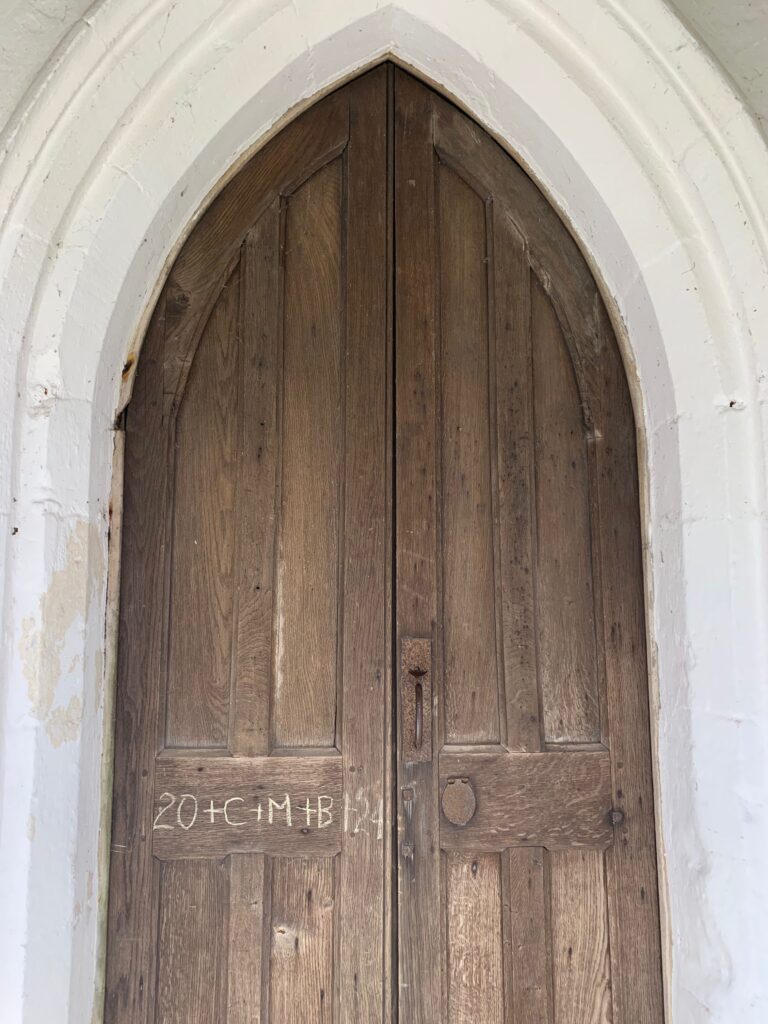
Elisha and the Shunammite woman
Grateful for the blessing, I unlatch the door and enter the church. Inside I find a pilgrimage stamp to add to my growing collection. There are some delightful carved folding panels at the ends of the pews, and a stained glass East window which depicts the Biblical story of Elisha and the Shunammite woman (2 Kings Chapter 4). Although this story has a happy and miraculous ending, it centres around the heart-rending loss of a much-loved only child. The window depicts the stricken mother, holding her dead son in her arms. I am reminded again of the theme of bereaved parents which seems to be following me this weekend.
Mad March hares
Back out in the sunshine, I continue along quiet lanes, mulling over my thoughts as I walk. Two medium-sized brown animals grab my attention as they dash across open farmland. At first I think they’re Muntjac deer, but then I realise they’re hares. Enormous, mad March hares, running, boxing one another, literally haring at a tremendous pace up and down the wide fields. They leap the ditches effortlessly, bounding with life. I stop and watch them for a while, entranced by their speed and energy. If I could cover the ground at even half their pace I’d have reached my destination long ago.

Whepstead and Saint Petronilla
Trudging onward at my more sedate tempo, I pass woodland and follow signs for the Bury to Clare Walk across waterlogged fields into the village of Whepstead. Here I notice a rather fine brick-built bus shelter which doubles as a free library. Beside it is the village sign, depicting Saint Petronilla, to whom the village church is dedicated.
Petronilla is the patron saint of mountain travellers and hospitality. She seems to have been an early Christian martyr, possibly a daughter, either biological or spiritual, of Saint Peter. Her remains are interred in a chapel in St Peter’s Basilica in Rome. The Whepstead village sign shows her as a veiled, nun-like woman offering a drink of water to a beggar in a rural Suffolk setting. Close beside the saint, a craftsman sits on a bench weaving baskets, with a labourer working in a field behind him, and the village church in the background. I’m definitely a traveller, even if Suffolk is rather short on mountains, so I’m happy to accept Petronilla’s friendly patronage for the next stretch of my journey.
Around the corner, along a leafy lane, Saint Petronilla’s church – the only one dedicated to her in England – is charming and well-kept. A window depicts Petronilla – this version a beautiful young woman with golden hair – side by side with Saint Peter. I spot a pile of old hymn books – 100 Hymns for Today – and am transported straight back to my schooldays, when we used to sing from this book at assemblies and in the school chapel. Jars of honey and home made jam are on sale, and I select a local honey to take home as a tasty souvenir of my visit.
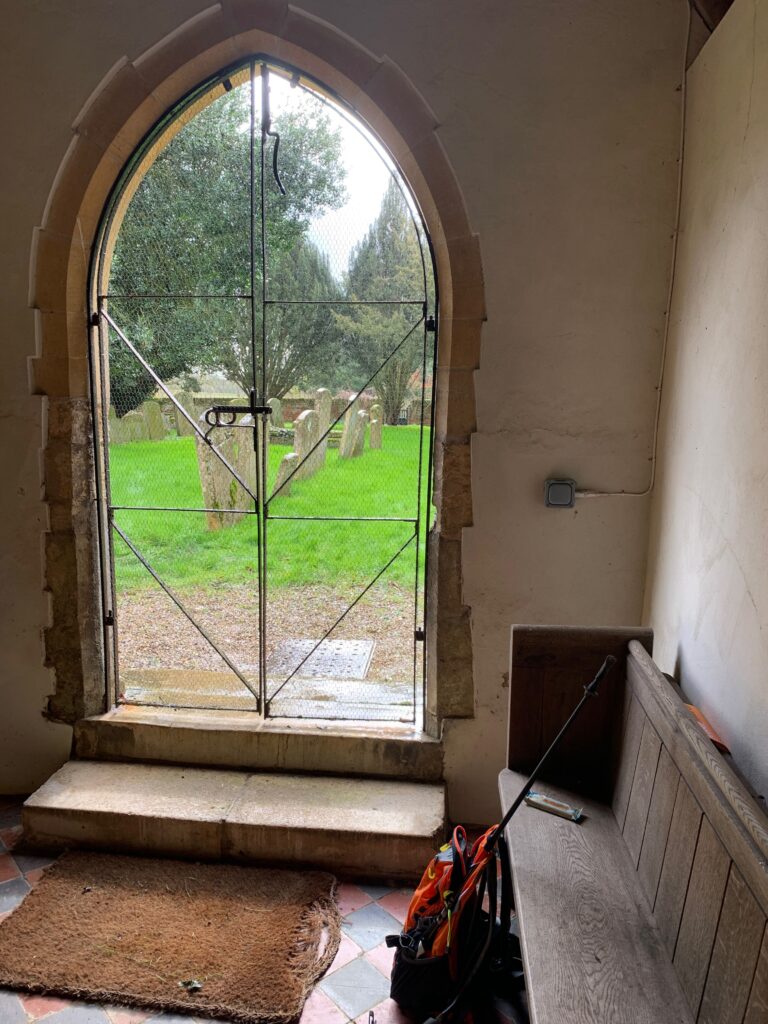
After signing the visitor’s book I’m about to set off again, when I realise the sunshine has been replaced by a sudden downpour. So I sit down in the porch to munch an energy bar and wait for the rain to pass. I’ve gained a whole new appreciation of church porches on this pilgrimage!
Thankfully it’s only a brief shower, and I’m soon heading out of Whepstead. There’s a pub somewhere nearby where could stop for lunch, but I’m keen to reach Bury St Edmunds with plenty of time to finish exploring the city in daylight. I decide to press on. I pass an attractive Baptist church with gothic windows and little turrets on my way out of the village. The welcoming notice board suggests there’s a lively worshipping community here, with friendly links with the Anglicans. Then I’m heading out into the countryside again for a peaceful walk the last few miles into Bury.
A rainbow, and wet feet
The lanes and footpaths are very quiet. I listen to some music on my headphones, singing along as I go. A rainbow arches across the fields ahead of me, and I feel my spirits lift. Life, like the weather, has its showers as well as sunshine, but there are always reasons to be hopeful.
Approaching Bury St Edmunds, the fields morph gently into parkland. I know I’ve reached civilisation when I see an ice cream van parked beside a children’s playground. Then it’s on past the hospital – I recall the taxi driver’s wife who probably works here – and across suburban streets. Today’s walk holds one last surprise, though. Just as I’m approaching the city centre, my path plunges suddenly underwater. The nearby River Linnet has burst its banks. Unwilling to turn back, I splash on, the water covering my boots and reaching up past my ankles. My feet are soaked, but I’m almost there.
Skirting the back of the Greene King brewery, I find my way back to the Chantry Hotel in the old centre of Bury St Edmunds. I remove my wet boots and muddy over-trousers with a sense of quiet triumph – I’m officially halfway to Walsingham!
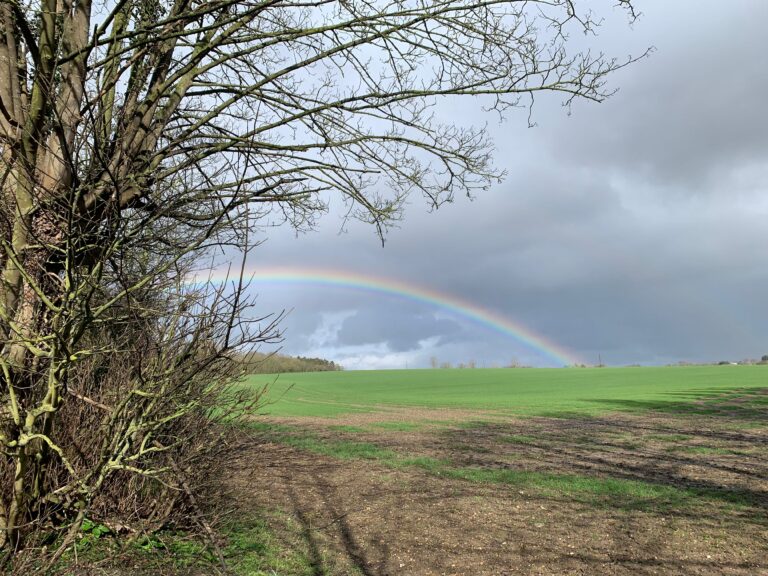
Karen Lawrence is a mother, grandmother, yoga teacher and writer. She lives with husband Adrian and youngest daughter Martha in Billericay, Essex, United Kingdom. Karen has published two books and is currently working on a novel about outlaw midwives in a dystopian future Britain.
Letting the Light In: How A Baby With Down Syndrome Changed My Life is Karen’s personal account of having a baby with Down Syndrome. It is available from Amazon at
Karen’s first book, Finding Your Calm Space: Thirty-One Ways to find Calm in a Crazy World is available from Amazon at
If you would like to follow Karen and be kept up to date with her writing, please sign up at https://karenlawrenceauthor.com/join-the-mailing-list/
http://www.suffolkchurches.co.uk/hawkedon.htm
https://www.chelmsfordcatholic.co.uk/epiphany-blessings
http://www.suffolkchurches.co.uk/rede.htm
http://www.suffolkchurches.co.uk/whepstead.htm

